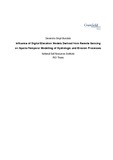JavaScript is disabled for your browser. Some features of this site may not work without it.
| dc.contributor.advisor | Taylor, J. C. | en_UK |
| dc.contributor.author | Bundela, Devendra Singh | en_UK |
| dc.date.accessioned | 2005-11-23T13:48:56Z | |
| dc.date.available | 2005-11-23T13:48:56Z | |
| dc.date.issued | 2004-11 | en_UK |
| dc.identifier.uri | http://hdl.handle.net/1826/796 | |
| dc.description.abstract | LISEM, a physically-based distributed and dynamic erosion model within the PCRaster GIS, is used to investigate the influence of different spatial representations of input parameters on surface hydrologic and erosion processes at three antecedent soil moisture levels for a 6-hour heavy storm at catchment scale. Two derived DEMs viz. Cartometric and PulSAR DEMs and three public domain DEMs viz. Landmap, ASTER and SRTM were used in this study. These five DEMs of various original resolutions along with a land use and land cover map and a soil map of the Saltdean catchment were resampled into five spatial representations at 20, 40, 60, 80 and 100 m grid-cell sizes to create input parameters at each resolution. Spaceborne radar interferometry was investigated for generating a suitable DEM for modelling in the context of developing countries having poor availability of quality DEMs. The land use and land cover map was derived from SPOT-1 data and the infiltration parameters were estimated from the 1:250 000 soil map using pedotransfer functions. Crop, soil and soil surface parameters were estimated for possible field conditions in the catchment. Subsequently, twenty-five LISEM databases of 30 input parameters each were created in PCRaster and tested in the model. The results show that at increasing the grid-cell size of a DEM, the slope gradient flattens and the drainage length shortens. Both of these have competing effects on runoff and sediment flow routing. The catchment area also increases at larger grid-cell sizes and influences these processes, which are then normalised for the comparison of various resolution results. In the absence of observed runoff and average soil loss data, a relative evaluation across resolutions and DEMs was carried out in the context of developing countries. The results indicate that the PulSAR and Landmap DEMs have higher variations in runoff and average soil loss than the ASTER DEM, Cartometric DEM, and SRTM DEM at coarser resolutions at all three moisture levels with respect to their result at 20 m. The SRTM DEM has lower variability than other DEMs at finer resolutions. It is demonstrated that resampling a medium resolution SRTM DEM at smaller grid-cell sizes does not improve the prediction of runoff and soil erosion. At 100 m resolution, the runoff is over predicted as compared to an 80 m resolution. Hence, high resolution DEMs should be resampled to 80 m grid-cell size, but the resampling reduces the spatial variability drastically. The results also indicate that the prediction of runoff is improved for the PulSAR DEM and Landmap DEM, and is slightly improved for the ASTER DEM as compared to the Cartometric DEM, but it is not improved for the SRTM DEM. It is related with their slope gradients. The results support that the average soil loss is improved for the PulSAR DEM and Landmap DEM and is slightly degraded for the SRTM DEM as compared to the Cartometric DEM. It also suggests that both are suitable for erosion prediction due to higher slope gradient mapped by remote sensing. The ASTER DEM did not produce reliable soil losses at all the moisture levels. Therefore, it should not be used for the prediction of soil erosion. The results also indicate that small grid-cell size produces detailed soil erosion and deposition outputs, which help in identifying the exact location of sediment source and sink areas necessary for planning the effective conservation strategy in the catchment. | en_UK |
| dc.format.extent | 1946 bytes | |
| dc.format.extent | 16377513 bytes | |
| dc.format.mimetype | text/plain | |
| dc.format.mimetype | application/pdf | |
| dc.language.iso | en | en_UK |
| dc.publisher | Cranfield University | en_UK |
| dc.title | Influence of digital elevation models derived from remote sensing on spatio-temporal modelling of hydrologic and erosion processes | en_UK |
| dc.type | Thesis or dissertation | en_UK |
| dc.type.qualificationlevel | Doctoral | |
| dc.type.qualificationname | PhD | |
| dc.publisher.department | Cranfield University at Silsoe |
